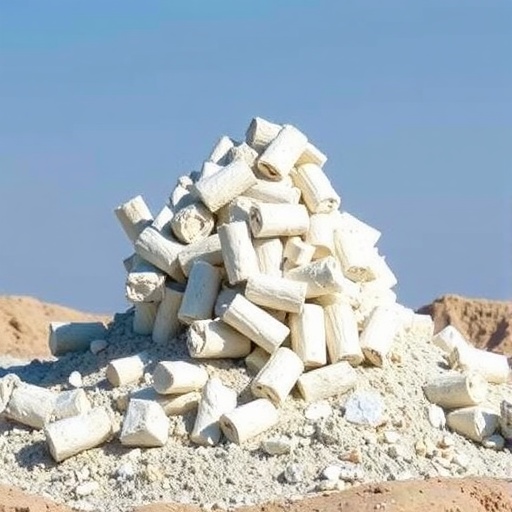In recent years, the construction industry has faced tremendous pressure to adopt more sustainable practices. This is due, in part, to the rising awareness of environmental issues and the need for a more responsible approach to building materials. Among the innovations emerging from this need is the integration of waste materials into concrete production, which offers not only an avenue for sustainable construction but also a way to address the critical waste disposal problem plaguing many urban areas.
A new study spearheaded by researchers Santhosh, S., Raghunathapandian, P., and Thanaraj, M.S. has highlighted a revolutionary approach to concrete that utilizes triple waste aggregates. This approach represents a hybrid synergy that enhances the performance of self-compacting geopolymer concrete while promoting sustainability. The study, published in the journal Waste Biomass Valor, presents compelling evidence that the use of waste materials can improve the properties of concrete while simultaneously reducing environmental impacts.
The researchers focused on integrating various types of waste aggregates, specifically those derived from industrial and urban waste, into the concrete matrix. By doing so, they aimed to challenge the traditional reliance on natural aggregates, resources that are increasingly difficult to source sustainably. The careful selection of waste materials, including fly ash, recycled aggregates, and other industrial by-products, forms the foundation of their innovative concrete mix, which not only achieves structural integrity but also meets sustainability goals.
One of the key findings of this study is that the inclusion of waste aggregates significantly contributes to the mechanical properties of the concrete. For instance, the compressive strength, workability, and durability of the geopolymer concrete were markedly enhanced when compared to conventional mixtures. This increase in performance metrics is vital as it demonstrates that sustainability does not come at the expense of structural efficacy. Rather, the judicious integration of waste aggregates can lead to superior materials.
Moreover, the study also addressed the environmental impacts of using waste aggregates in concrete production. By sourcing materials that would otherwise contribute to landfills, the researchers effectively reduced the carbon footprint associated with standard concrete production. The environmental benefits gain momentum when considering that the production of traditional Portland cement is highly energy-intensive and emits significant amounts of CO2 into the atmosphere. As a result, using geopolymer concrete with waste aggregates presents an appealing alternative that aligns with global efforts in climate action and sustainable development.
Furthermore, the researchers examined how self-compacting characteristics of the geopolymer concrete could be optimized using waste materials. Self-compacting concrete is a crucial advancement in the field as it reduces labor costs and improves efficiency during the pouring process. The integration of waste aggregates results in improved flowability, reducing the risk of segregation and allowing for a more uniform placement, which ultimately enhances the performance of concrete structures.
The implications of this study extend beyond mere material science; they touch upon broader socio-economic aspects. Implementing this technology could create new job opportunities within the waste management and recycling sectors, as it necessitates a continuous supply of waste aggregates. This creates a circular economy where waste materials are repurposed rather than discarded, thereby fostering a more sustainable community.
Moreover, policymakers could take cues from the findings of this research, advocating for regulations that encourage the use of recycled materials in construction projects. By establishing standards and offering incentives for using sustainable practices, governments can play a fundamental role in transitioning the construction industry toward greener methodologies.
Industry stakeholders, including civil engineers, architects, and construction firms, should also consider the benefits of adopting this innovative material. The allure of sustainable practices paired with superior performance could serve as a competitive edge in a marketplace that increasingly values eco-friendly solutions. By investing in technologies like the one presented in this study, companies can not only enhance their marketability but also contribute to a healthier planet.
Despite these advancements, the study does acknowledge certain challenges that must be navigated for the wider adoption of waste aggregate-reduced geopolymer concrete. These include standardization of materials, addressing potential segregation, and ensuring quality control in production. Continuous research and collaboration will be critical in developing guidelines that optimize the use of waste aggregates while mitigating risks.
The climate crisis necessitates immediate action from all sectors, and the construction industry is no exception. The exploration of waste-derived materials in concrete exemplifies a proactive approach to resource management that embodies innovation, sustainability, and quality. As shown by Santhosh and colleagues, this research not only contributes to building better infrastructures but also lays the groundwork for a more sustainable future.
In conclusion, the integration of triple waste aggregates into self-compacting geopolymer concrete marks a significant milestone in construction materials science. This groundbreaking study provides a roadmap for future innovations in sustainable construction, encouraging the exploration and utilization of waste materials. With further research and adoption, the building sector can make strides toward reducing waste, lowering carbon emissions, and creating a more sustainable built environment for generations to come.
The balance between concrete quality and sustainability is now within reach, and the findings from this study could potentially reshape the industry’s standards significantly. A focus on sustainable practices in concrete production is not just an option anymore but a necessary evolution of construction norms that we cannot afford to ignore.
Subject of Research: Integration of triple waste aggregates into self-compacting geopolymer concrete for sustainability.
Article Title: Triple Waste Aggregates Integration for Sustainable Self-Compacting Geopolymer Concrete: A Hybrid Synergy
Article References:
Santhosh, S., Raghunathapandian, P., Thanaraj, M.S. et al. Triple Waste Aggregates Integration for Sustainable Self-Compacting Geopolymer Concrete: A Hybrid Synergy.
Waste Biomass Valor (2025). https://doi.org/10.1007/s12649-025-03405-x
Image Credits: AI Generated
DOI: https://doi.org/10.1007/s12649-025-03405-x
Keywords: Sustainable construction, geopolymer concrete, waste aggregates, self-compacting concrete, circular economy, environmental sustainability.
Tags: environmental impact of construction materialsgeopolymer concrete innovationshybrid synergy in concrete productionindustrial waste recycling in constructionreducing reliance on natural aggregatesself-compacting concrete performancesustainable building materials developmentsustainable construction practicestriple waste aggregates in constructionurban waste disposal solutionswaste material integration in concrete





